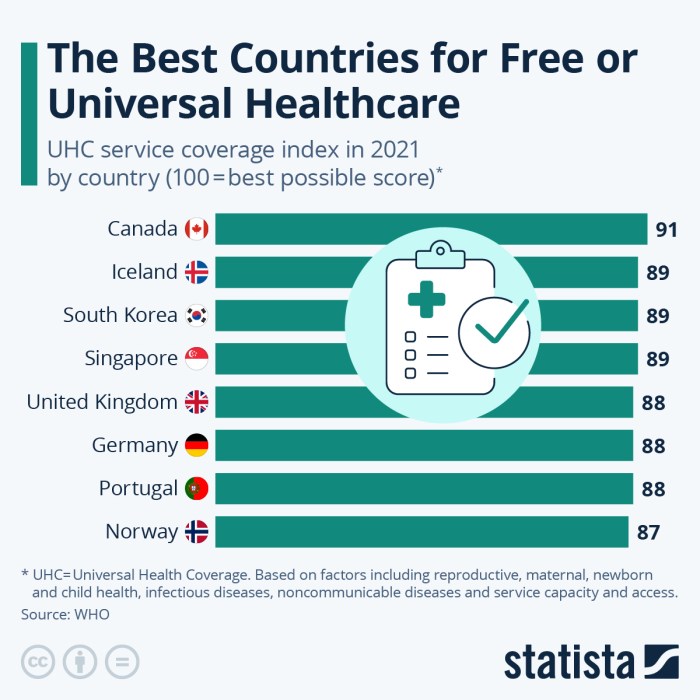Best Countries for Affordable Private Health Insurance
Exploring the best countries for affordable private health insurance, this introduction sets the stage for a comprehensive discussion on the topic.
Delving into the factors that influence the affordability of private health insurance and highlighting examples of countries known for their cost-effective insurance offerings.
Overview of Affordable Private Health Insurance in Different Countries
Private health insurance affordability varies significantly across different countries due to various factors such as healthcare system structure, government regulations, cost of living, and overall health expenditure. Let's explore some countries known for offering affordable private health insurance options to their residents.
Affordability of Private Health Insurance
- Germany: Germany is known for its universal healthcare system and mandatory health insurance coverage for all citizens. Private health insurance in Germany is relatively affordable due to a competitive market and a wide range of coverage options.
- Japan: Japan has a well-established healthcare system with both public and private insurance options. Private health insurance in Japan is affordable for many residents, with low out-of-pocket costs and comprehensive coverage.
- Australia: Australia offers a mix of public and private healthcare services, making private health insurance accessible and affordable for its citizens. The government also provides incentives and subsidies to encourage more people to opt for private insurance.
Key Factors Contributing to Affordability
- Regulatory Environment: Countries with strong regulations and policies governing private health insurance tend to have more affordable options for their residents.
- Competition Among Insurers: A competitive insurance market often leads to lower premiums and better coverage options for consumers.
- Government Support: Some governments provide subsidies, tax incentives, or other forms of support to make private health insurance more affordable for their populations.
Examples of Countries with Affordable Private Health Insurance
- Switzerland: Switzerland has a highly efficient healthcare system with a mix of public and private insurance options. Private health insurance in Switzerland is known for its quality coverage and relatively affordable premiums.
- Netherlands: The Netherlands has a mandatory health insurance system that offers a variety of private insurance plans at competitive prices. The government also provides financial assistance to low-income individuals to help them afford coverage.
Factors Influencing the Affordability of Private Health Insurance

Government Policies and Regulation:Government policies play a crucial role in regulating the costs of private health insurance. Regulations such as price controls, mandatory coverage requirements, and subsidies can impact the affordability of private health insurance plans for individuals and families.
For example, in some countries, the government may implement price ceilings to prevent insurance providers from charging exorbitant premiums, making coverage more accessible to a broader population.Healthcare System Structure:The structure of the healthcare system in a country can also significantly impact the affordability of private health insurance.
For instance, in countries where healthcare costs are generally lower due to efficient systems and reduced administrative overhead, private health insurance premiums are likely to be more affordable. On the other hand, countries with complex healthcare systems and higher overall healthcare costs may see a corresponding increase in private health insurance premiums.Competition Among Insurance Providers:Competition among insurance providers can influence the pricing of private health insurance plans.
In a competitive market, insurance companies may offer lower premiums and better coverage options to attract customers. This competitive pressure can drive down prices and improve the affordability of private health insurance for consumers. Conversely, in markets with limited competition, insurance providers may have more control over pricing, potentially leading to higher costs for policyholders.
Case Studies of Countries with Exceptional Private Health Insurance Systems
When it comes to private health insurance, some countries have managed to establish exceptional systems that prioritize affordability for their citizens. Let's take a closer look at some of these countries and how they achieve this.
Germany
Germany is known for its robust private health insurance system, which operates alongside the public system. One of the key factors contributing to the affordability of private health insurance in Germany is the competition among insurance providers. This competition helps keep premiums relatively low while still offering comprehensive coverage to policyholders.
Additionally, the government regulates the insurance market to ensure transparency and fair pricing, further benefiting consumers.
Switzerland
Switzerland is another country with a well-established private health insurance system that remains affordable for its residents. One unique feature of the Swiss system is the mandatory health insurance requirement for all citizens, which creates a large risk pool and helps distribute costs more evenly.
The government also provides subsidies to lower-income individuals to ensure access to essential healthcare services. Furthermore, insurers in Switzerland are not allowed to make a profit on basic health insurance, preventing excessive price hikes.
Singapore
Singapore stands out for its innovative approach to private health insurance, with the introduction of Health Savings Accounts (HSA) to help individuals set aside funds for medical expenses. The government also promotes price transparency and competition among healthcare providers to drive down costs for consumers.
Additionally, Singaporeans benefit from a mix of public and private healthcare options, allowing for greater choice and flexibility in accessing quality care while maintaining affordability.
Strategies for Ensuring Affordable Private Health Insurance Coverage
In order to make private health insurance more affordable, countries can implement various strategies that focus on reducing costs and improving access to quality healthcare. One key factor in achieving this goal is the role of technology and digitization in streamlining administrative processes and lowering overall expenses for private health insurance providers.
Role of Technology and Digitization
Technology plays a vital role in reducing administrative costs associated with private health insurance. By implementing electronic health records, online claims processing, and telemedicine services, insurers can streamline their operations and cut down on paperwork and manual tasks. This not only improves efficiency but also helps in reducing costs, making private health insurance more affordable for consumers.
- Electronic Health Records (EHR): The use of EHR systems enables healthcare providers to access patient information digitally, leading to more efficient and coordinated care. This technology eliminates the need for paper records, reducing administrative costs for insurers.
- Online Claims Processing: By automating the claims process through online portals, insurers can expedite claim approvals and reduce processing times. This not only benefits policyholders but also helps in cutting down on administrative expenses.
- Telemedicine Services: Telemedicine allows patients to consult with healthcare providers remotely, eliminating the need for in-person visits. This not only enhances accessibility to healthcare services but also lowers overall healthcare costs, making private health insurance more affordable.
Successful Initiatives for Affordability
Several countries have successfully implemented initiatives aimed at improving the affordability of private health insurance. One notable example is Singapore's Medisave scheme, which allows citizens to set aside a portion of their income into a dedicated account for healthcare expenses.
This helps in reducing out-of-pocket costs for medical services and promotes savings for future healthcare needs.
Singapore's Medisave scheme is a prime example of a successful initiative that has contributed to making private health insurance more affordable for its citizens.
Another successful approach is Germany's dual healthcare system, which combines both public and private health insurance options. This system ensures that individuals have access to quality healthcare services through a mix of public coverage and private insurance, catering to different income levels and needs.Overall, leveraging technology, implementing innovative schemes, and adopting a multi-faceted approach are key strategies that countries can utilize to ensure affordable private health insurance coverage for their populations.
Closing Summary
In conclusion, the discussion on the best countries for affordable private health insurance sheds light on the importance of accessible healthcare options globally.
User Queries
Which country is known for offering the most affordable private health insurance?
Answer: Countries like X and Y are recognized for providing affordable private health insurance options to their residents.
How do government policies impact the affordability of private health insurance?
Answer: Government regulations play a crucial role in shaping the costs of private health insurance, making it more or less affordable for individuals.
Are there any innovative features in certain countries' private health insurance systems?
Answer: Yes, countries like Z have introduced innovative features in their private health insurance systems to enhance affordability and accessibility.




